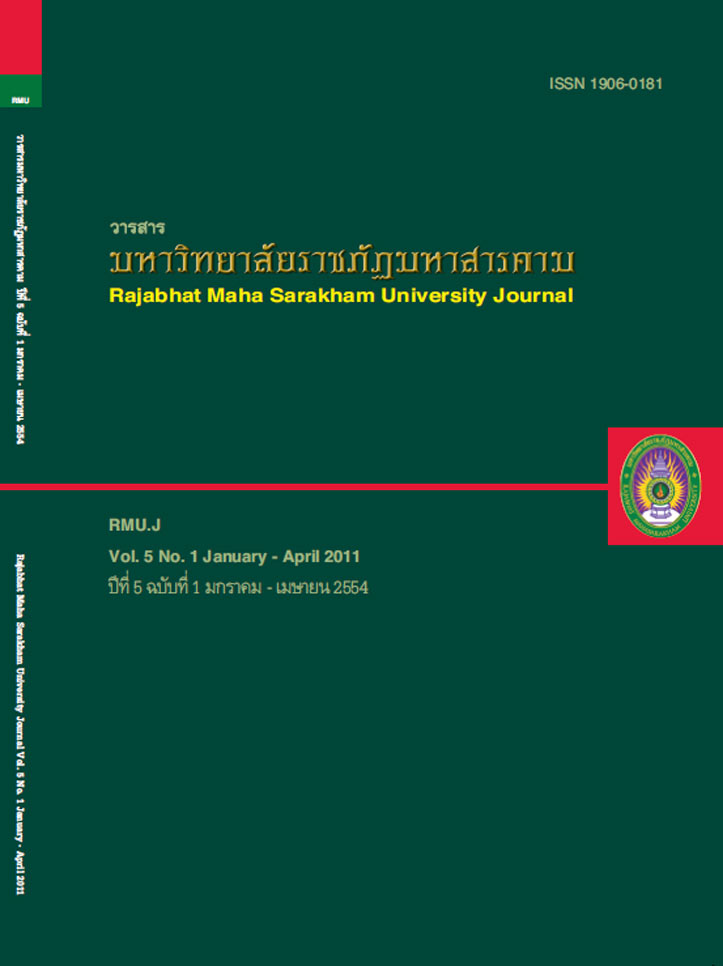ผลการเรียนรู้ กลุ่มสาระการเรียนรู้คณิตศาสตร์ เรื่อง อสมการ ชั้นมัธยมศึกษาปีที่ 3 โดยใช้การจัดกิจกรรมการเรียนรู้แบบร่วมมือ; The Learning Outcomes of Mathematics Subject Group on Non-Equation for 9th Grade Education, Using the Collaborative Learning Method
Main Article Content
บทคัดย่อ
การวิจัยครั้งนี้มีจุดประสงค์ ประการแรก เพื่อพัฒนากิจกรรมการเรียนรู้ โดยใช้แผนการจัดกิจกรรมการเรียนรู้แบบ
ร่วมมือ กลุ่มสาระการเรียนรู้คณิตศาสตร์ เรื่อง อสมการ ชั้นมัธยมศึกษาปีที่ 3 ที่มีประสิทธิภาพตามเกณฑ์ 75/75 ประการที่สอง
เพื่อเปรียบเทียบผลสัมฤทธิ์ทางการเรียน กลุ่มสาระการเรียนรู้คณิตศาสตร์ เรื่อง อสมการ ชั้นมัธยมศึกษาปีที่ 3 โดยใช้การจัด
กิจกรรมการเรียนรู้แบบร่วมมือ กับเกณฑ์ที่กำหนด ร้อยละ 75 ประการที่สาม เพื่อศึกษาความพึงพอใจในการเรียนรู้ของนักเรียน
ชั้นมัธยมศึกษาปีที่ 3 ที่เรียนด้วยแผนการจัดการเรียนรู้ กลุ่มสาระการเรียนรู้คณิตศาสตร์ เรื่อง อสมการ ชั้นมัธยมศึกษาปีที่ 3
โดยใช้การจัดกิจกรรมการเรียนรู้แบบร่วมมือ กลุ่มตัวอย่างที่ใช้ในการวิจัย ได้แก่ นักเรียนในระดับชั้นมัธยมศึกษาปีที่ 3 ภาคเรียน
ที่ 2 ปีการศึกษา 2552 โรงเรียนวังลิ้นฟ้าวิทยาคม อำเภอห้วยเม็ก จังหวัดกาฬสินธุ์ สำนักงานเขตพื้นที่การศึกษากาฬสินธุ์ เขต 2
จำนวน 42 คนได้มาโดยวิธีการสุ่มแบบเจาะจง (Purposive Sampling) เครื่องมือที่ใช้ในการวิจัย ได้แก่ แผนการจัดการเรียนรู้
กลุ่มสาระการเรียนรู้คณิตศาสตร์ เรื่อง อสมการ ชั้นมัธยมศึกษาปีที่ 3 โดยใช้การจัดกิจกรรมการเรียนรู้แบบร่วมมือ จำนวน 10
แผน แบบทดสอบวัดผลสัมฤทธิ์ทางการเรียน ชนิดปรนัยชนิดเลือกตอบ 4 ตัวเลือก จำนวน 30 ข้อ มีค่าอำนาจจำแนก (B) รายข้อ
ตั้งแต่ 0.22 ถึง 0.53 ค่าความเชื่อมั่น (rcc) ทั้งฉบับเท่ากับ 0.79 และแบบวัดความพึงพอใจในการเรียนรู้ ชนิดมาตราส่วนประมาณ
ค่า (Rating Scale) จำนวน 20 ข้อ มีค่าอำนาจจำแนก (t) รายข้อตั้งแต่ 0.25 ถึง 0.68 และค่าความเชื่อมั่น (α) เท่ากับ 0.79
สถิติที่ใช้ในการวิเคราะห์ข้อมูล ได้แก่ ร้อยละ ค่าเฉลี่ย ส่วนเบี่ยงเบนมาตรฐาน และทดสอบสมมติฐานโดยใช้ t–test
(Dependent samples) ผลการวิจัยพบว่า
1. แผนการจัดการเรียนรู้ กลุ่มสาระการเรียนรู้คณิตศาสตร์ เรื่อง อสมการ ชั้นมัธยมศึกษาปีที่ 3 โดยใช้การจัด
กิจกรรมการเรียนรู้แบบร่วมมือ ที่ผู้วิจัยสร้างขึ้นมีประสิทธิภาพเท่ากับ 80.47 / 78.65 ซึ่งสูงกว่าเกณฑ์ที่ตั้งไว้
2. ผลสัมฤทธิ์ทางการเรียนหลังเรียน โดยใช้การจัดกิจกรรมการเรียนรู้แบบร่วมมือ กลุ่มสาระการเรียนรู้คณิตศาสตร์
เรื่อง อสมการ ชั้นมัธยมศึกษาปีที่ 3 สูงกว่าเกณฑ์ ร้อยละ 75 อย่างมีนัยสำคัญทางสถิติที่ระดับ .01
3. ความพึงพอใจในการเรียนรู้ของนักเรียนชั้นมัธยมศึกษาปีที่ 3 ที่เรียนรู้ด้วยแผนการจัดการเรียนรู้ กลุ่มสาระการเรียนรู้คณิตศาสตร์ เรื่อง อสมการ โดยใช้การจัดกิจกรรมการเรียนรู้แบบร่วมมือโดยรวมอยู่ในระดับมาก
Mathematics plays an important role in our daily lives. It develops human’s thinking process,
promotes critical thinking and analysis, as well ass aids planning and problem solving. However,
Mathematics lessons provided by schools up to the present days had not been very successful. Parts of
the problems were from teachers whose lessons were based solely on following textbooks. In brief, the
teachers gave lectures based on the contents in textbooks and students did exercises in the textbooks
as well. The students were not provided with opportunities to analyze or think critically in order to solve
the problems. In addition, the students did not know how to obtain knowledge by themselves and lacked
analyzing skills for problem solving. There resulted in the lack of good attitude towards Mathematics and
motivation to learn. Therefore, the objectives of this study were (1) to develop Mathematics learning
activities for 9th grade students based on the cooperative and collaborative learning model with the aim
of meeting the 75/75 standard, (2) to compare academic outcomes of 9th grade students who studied
Mathematics on the subject of inequality employing the developed learning activities to the 75%
standard and (3) to assess the students’ satisfaction with the developed learning activities for the
subject of inequality. The sample consisted of 42 9th grade students in the second semester of
Academic Year 2009 from Wanglinpha Wittayakom School, Huai Mek District, the Office of Educational
Area 2, Kalasin Province. The sample was recruited by means of purposive sampling. The research
instrument employed in this study was a set Mathematics lesson plans on the subject of inequality for 9th
grade level. The lesson plans comprised ten plans. The test for academic results consisted of 30 fourchoice
questions with discrimination values (B) for individual questions ranging from 0.22 to 0.53 and
total reliability (rcc) for the whole test of 0.79. An instrument for testing the students’ satisfaction was a
rating-scale questionnaire containing 20 questions with discrimination value (t) for individual questions
ranging from 0.25 to 0.68 and reliability (α) for the whole test of 0.79. The data were analyzed employing
paired t-test.
The results of the study are described as follows.
1. The efficiency of the created lesson plans for Mathayomsuksa 3 students was 80.47/78.65,
which was above the established standard.
2. The post-lesson academic outcomes on the subject of inequality of Mathayomsuksa 3
students who learned via the learning activities students based on the cooperative and collaborative
learning model was higher than the 75% standard at the significance level of.01.
3. The level of Mathayomsuksa 3 students’ satisfaction with the Mathematic learning activities
on the subject of inequality was at a high level.
In conclusion, efficient Mathematics lesson plan could be developed based on the cooperative
and collaborative learning model.
Article Details
1. บทความที่ลงตีพิมพ์ทุกเรื่องได้รับการตรวจทางวิชาการโดยผู้ประเมินอิสระ ผู้ทรงคุณวุฒิ (Peer Review) สาขาที่เกี่ยวข้อง อย่างน้อย 3 ท่าน ในรูปแบบ Double blind review
2. ข้อคิดเห็นใด ๆ ของบทความที่ลงตีพิมพ์ในวารสารมหาวิทยาลัยราชภัฏมหาสารคาม นี้เป็นของผู้เขียน คณะผู้จัดทำวารสารไม่จำเป็นต้องเห็นด้วย
3. กองบรรณาธิการวารสารมหาวิทยาลัยราชภัฏมหาสารคาม ไม่สงวนสิทธิ์การคัดลอกแต่ให้อ้างอิงแสดงที่มา


